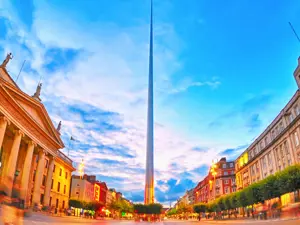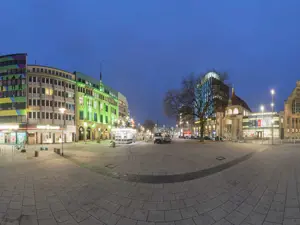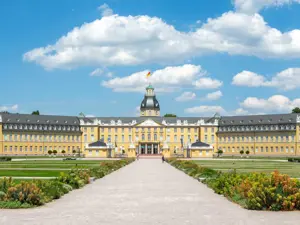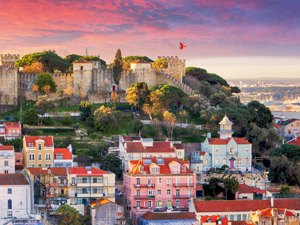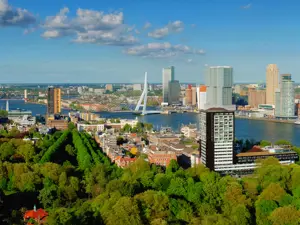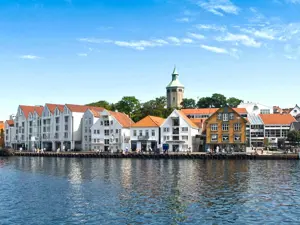The university city
Craiova, a university city in the south of Romania, is an important industrial, commercial, cultural and scientific centre with a strong academic tradition. Universitatea Craiova (Craiova University), founded in 1947, comprises 20 faculties and 32,000 students and is twinned with the University of Bergamo.

Universitatea Craiova. Copyright © Sisterscom.com / Shutterstock
The same university expresses one of the most famous Romanian soccer teams: Universitatea Craiova is one of the most titled football teams in Romania with important victories in European cups.
Places of worship in Craiova
Like all cities in Romania, Craiova has numerous places of worship that bear witness to the great faith of the population. Most of the religious buildings date back to the medieval period.
The St. Demetrius Cathedral
The most beautiful church of the city, which is also rich in history, is Biserica Domneasca Sfantu Dumitru (the church dedicated to St. Demetrius), which was built on the foundations of an old church erected in the sixteenth century by the boyars of the Craiovesti family. After the earthquake of 1838, which caused considerable damage, the church was completely reconstructed according to the drawings of the French architect Emile Lecompte de Nouy, restored in 1903 and again in 1933 when internal murals were painted by the French artists Menipot and Boriès. Today it is the Metropolitan Cathedral of Oltenia and houses the relics of St. Tatiana.

The St. Demetrius Cathedral. Copyright © Sisterscom.com / Shutterstock
The St. Ilie church in Craiova
Other important churches include the one dedicated to St. Ilie, built in 1720 and restored according to the drawings of the architect Springler, which preserves murals painted by the celebrated artist Gheorghe Tattarescu (the father of Romanian neoclassicism), and the Churches of St Nicolas, Stirbei and “Madona Dudu”. The Church of Cosuna Monastery is an interesting 15th century building situated on the outskirts of Craiova.

St. Ilie church. Copyright © Sisterscom.com / Shutterstock
Between the end of the 17th century and the beginning of the 18th century, Craiova’s architecture underwent a transformation with the creation of the Brancovenesti style, a combination of traditional Romanian, Byzantine and Venetian art.
Craiova, as former capital of the region, has numerous places associated to the history of the boyars who lived here: the “Baniei” (Boyars’) House dating back to 1699 commissioned by Constantin Brancoveanu (a famous Romanian sculptor), “Glogoveanu” House (1802), “Jianu” House (eighteenth century), and the former justice building, now seat of the University.
The fountains in Craiova
Don’t miss seeing the numerous fountains: Popova (1651), Obedeanu (1774), Jianu (1800) and “Fantana Rosie” (red fountain) built between 1850-1870.

The fountains. Copyright © Sisterscom.com / Shutterstock
The museums in Craiova
To learn more about the history and traditions of the city and the region of Craiova, a visit to the Oltenia Museum is recommended. Housed in Baniei House, an old non-religious building, it features more than 12,000 objects in sections concerning history and archaeology, ethnography and nature.

Craiova Art Museum. Copyright © Sisterscom.com / Shutterstock
Art lovers should not miss a visit to the Craiova Art Museum in the Mihail Dinu Palace, which was built at the beginning of the twentieth century in neoclassical style by a French architect. The Jitianu Monk Monastery, located a few miles south of the city centre, houses a rich collection of medieval art objects. The monumental Nicolae Romanescu park is a genuine example of urban landscape architecture and a green oasis in the city.
Text by Eugenio Sorrentino
Updated by Alisè Vitri
Video: www.romania.travel
Turism Board
www.romania.travel
Partnership with Booking.com
Where to sleep in Craiova

Craiova. Copyright © Sisterscom.com / Shutterstock
Craiova is a welcoming city and offers different possibilities for accommodation.
To find the ideal hotel and the best offers you can do a search for the stars and services.
AIRPORT
Hotels near the airports
WHERE TO GO in Craiova
Museums in Craiova

Craiova. Copyright © Sisterscom.com / Shutterstock
CRAIOVA ART MUSEUM
The sumptuous Neo-Baroque palace, which houses the museum, was completed in 1896. The main attraction of the museum is the art gallery dedicated to the Romanian sculptor Constantin Brancusi.

Craiova. Copyright © Sisterscom.com / Shutterstock
OLTENIA MUSEUM
Housed in the Bania House (Casa Baniei), an important historical and architectural monument in Craiova, this museum showcases the history of the region from prehistoric times. Great attention has been paid to the presentation of traditional trades and the occupations of farmers in Oltenia. The museum features wooden and ceramic sculptures, a vast collection of vases, bowls of all types, plates, rugs and a fascinating collection of local costumes.
Excursions in Craiova

Craiova. Copyright © Sisterscom.com / Shutterstock
TARGU JIU
100 km to the north west of Craiova
A must for all art lovers is a visit to Targu Jiu, on the banks of the River Jiu.
This former market town has close ties with Constantin Brancusi, considered by many to be the father of modern sculpture. While most of his works are exhibited in prestigious museums all over the world, his trilogy of public sculptures – Masa Tacerii (The Table of Silence), Poarta Sarutului (The Gate of the Kiss) and Coloana Infinitului (The Endless Column) – can be admired at the Constantin Brancusi Sculpture Complex in the centre of Targu Jiu.
A must for all art lovers is a visit to Targu Jiu, on the banks of the River Jiu.
This former market town has close ties with Constantin Brancusi, considered by many to be the father of modern sculpture. While most of his works are exhibited in prestigious museums all over the world, his trilogy of public sculptures – Masa Tacerii (The Table of Silence), Poarta Sarutului (The Gate of the Kiss) and Coloana Infinitului (The Endless Column) – can be admired at the Constantin Brancusi Sculpture Complex in the centre of Targu Jiu.

Craiova. Copyright © Sisterscom.com / Shutterstock
HOREZU MONASTERY AND THE HOREZU POTTERY CENTRE
150 km to the north of Craiova
The Horezu Monastery, the largest monastic settlement in Valacchia, was founded in 1690. A masterpiece of Brancoveni style and a UNESCO world heritage site, Horezu is renowned for the richness of its sculptural details, the treatment of its religious compositions and its decorative painted works. The monastery houses valuable collections of icons and frescoes dating back to the end of the seventeenth century and the beginning of the eighteenth century. The nearby village of Horezu is home to one of the largest pottery centres in Romania.
The Horezu Monastery, the largest monastic settlement in Valacchia, was founded in 1690. A masterpiece of Brancoveni style and a UNESCO world heritage site, Horezu is renowned for the richness of its sculptural details, the treatment of its religious compositions and its decorative painted works. The monastery houses valuable collections of icons and frescoes dating back to the end of the seventeenth century and the beginning of the eighteenth century. The nearby village of Horezu is home to one of the largest pottery centres in Romania.

Craiova. Copyright © Sisterscom.com / Shutterstock
CURTEA DE ARGES
150 km to the north east of Craiova
Another architectural gem can be found to the east of Horezu. The Monastery of Curtea de Arges (Manastirea Curtea de Arges), dating back to the sixteenth century, is topped with two towers that spiral in opposite directions.
Another architectural gem can be found to the east of Horezu. The Monastery of Curtea de Arges (Manastirea Curtea de Arges), dating back to the sixteenth century, is topped with two towers that spiral in opposite directions.
Partnership with GetYourGuide
All tours and excursions
Luxury
You might be interested in
Other destinations
Airports nearby Craiova

















